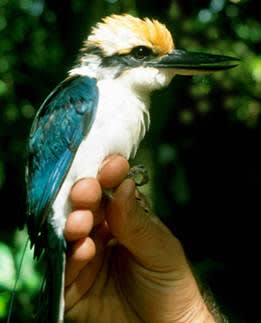Due to Loss of Native Birds, Arachnophobes May Want to Stay Away from Guam
OutdoorHub 09.17.12

A new study on the island of Guam reveals that the near-total loss of native birds caused by the invasive brown tree snake has led to a huge increase in the number of spiders. During certain times of the year, arachnids on Guam occur at 40 times the rate of nearby islands where the snake is absent and birds persist.
The study, conducted by researchers Haldre Rogers, Janneke Hille Ris Lambers, and Joshua J. Tewksbury from the University of Washington, and Ross Miller from the University of Guam, was just published in the online, peer-reviewed journal PLOS One.
The team counted spider webs along transect lines as a measure of prey abundance. Since there were no studies on the incidence of spiders on Guam prior to the eradication of native birds, the scientists compared the abundance of spider webs in forests on Guam to that on nearby Rota, Tinian, and Saipan that have no well-established snake populations and similar bird communities to Guam before the snake invasion there.
Guam had a mean of 18.37 spider webs per 10 meters (~33 ft.) in the wet season, compared to 0.45 webs per 10 meters on nearby islands with birds. In the dry season, Guam had 26.19 spider webs per 10 meters compared to 11.37 webs per 10 meters on nearby islands with birds. Thus, the ratio of spider webs on islands with birds to Guam, with very few birds, was 1:40.8 in the wet season and 1:2.3 in the dry season. These results not only show dramatic changes in abundance, they also point to the almost complete loss of seasonality in web-building behavior by the spiders. On the three islands with high bird abundance, spiders build 25-times more webs in the dry season than in the wet, but on Guam, the rate is almost consistent year round.
The brown tree snake was introduced to Guam in the mid-1940s, leading to the extirpation of all but four native forest bird species: the Long-tailed Koel (a type of cuckoo), Mariana Crow, Mariana Swiftlet, and Micronesian Starling. All of these remain in extremely localized populations, and in most other forest areas, have not been replaced by non-native species. This makes the forests of Guam a unique place to test the impacts of loss of bird populations on their former prey.
“We’ve known for some time that the introduction of the invasive brown tree snake was a disaster for the island’s native bird populations; now we are learning about some of the consequences of that loss of avian diversity,” said Dr. George Fenwick, President of American Bird Conservancy. “This study clearly illustrates the valuable function that birds provide in controlling invertebrate numbers, and the natural balance that birds bring to our environment.
Birds pollinate our crops, control crop pests, and, it would seem, keep spider populations from exploding.
“With the introduction of the brown tree snake and resultant loss of native birds, arachnophobes and those afraid of snakes would do well to stay out of the forests of Guam,” said Fenwick.

